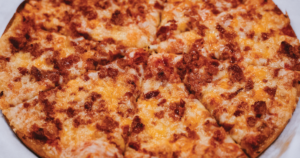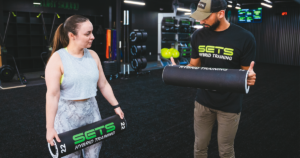 Occasionally, a younger tennis player will come along with the natural ability to accurately and correctly hit a regulation yellow tennis ball.
Occasionally, a younger tennis player will come along with the natural ability to accurately and correctly hit a regulation yellow tennis ball.
Most often, however, that is not the case. Newer tennis players, especially those that are younger, struggle with the bounciness of the tennis ball, the weight of it, and lack the ability to control it.
They resort to using any means necessary to strike the ball, which usually leads to hurried, out-of-sync and technically-flawed swings of desperation.
Tennis professional Bobby Gillespie, who runs BG Tennis at The Ridge and Estancia communities in Wiregrass Ranch, as well as at Live Oak Preserve in New Tampa and at Lake Jovita in Dade City, says he has seen young, overmatched beginners just trying to survive against the yellow balls too often, which is why he emphatically extols the virtues of using low-compression balls, and shorter courts, to properly teach them the game.
Most parents who get their children into tennis only know one kind of tennis ball, but Gillespie is quick to introduce them to red-, orange- and green-dot low-compression balls, which he calls revolutionary teaching tools.
The red-dot ball has 75 percent less ball speed than a regular yellow tennis ball, while the orange-dot ball is 50 percent slower and the green-dot ball is 25 percent slower.
The allows younger players to focus on technique, footwork and properly addressing each shot, not just hitting a ball back over a net. They can take full swings, as the ball is designed not to bounce as high or travel as far. Gillespie says that a beginner’s full swing at a yellow ball is likely to send it into the nearest fence.
“Whenever I have the opportunity, I try to sell the concept of these low-compression balls. It is something I am very passionate about,” says Gillespie, a former junior champion where he grew up in Shropshire, a county in England, and later a national university champion at Loughborough University in Loughborough, England, where he also earned a degree in sports management.
 While Gillespie says he didn’t need low-compression balls as a youngster himself because he was naturally gifted, very few beginners can claim that.
While Gillespie says he didn’t need low-compression balls as a youngster himself because he was naturally gifted, very few beginners can claim that.
“I’ve been here since 2005, and when I got here, no one was using them,” he says of the low-compression balls. “All the tennis coaches were using just the yellow balls, and you had to just deal with it. I was a bit confused why we were doing that.”
Gillespie was the head tennis pro at Cheval Country Club and later at Lake Jovita Country Club before starting BG Tennis in 2008 and developing what he says is a proven teaching formula to develop the proper tennis strokes in beginners while also making it fun.
Mixing a career of tennis knowledge with likability and a sense of humor, Gillespie teaches roughly 120 kids every week, as well as 80 or so adults. His progressive clinics are once a week, and affordable by tennis standards at just $65 a month – which is the price a one-hour lesson will cost you at most country clubs.
Get Them Started Early
Ideally, Gillespie says, kids in first through fifth grade are at the best ages to begin learning tennis.
Joe Caswell, who is nine years old, and his brother, six-year-old Max, have been with BG Tennis since August. They competed against each other on a recent Tuesday night at The Ridge, as their younger brother Luke, who is five, helped pick up balls.
 “I feel like they have made a ton of progress since we’ve been here,” says their mother, Amanda, who lives in Meadow Pointe III and has tried other coaches in the area. “I’ve seen a huge difference in their play. I just think they are so much more consistent, and (coach) stays on them about the little things.”
“I feel like they have made a ton of progress since we’ve been here,” says their mother, Amanda, who lives in Meadow Pointe III and has tried other coaches in the area. “I’ve seen a huge difference in their play. I just think they are so much more consistent, and (coach) stays on them about the little things.”
Amanda says she is a fan of the low- compression balls. They allow her sons to move to the ball, position their feet, set up and deliver the proper stroke. In the past, it was easier to develop bad habits adapting their swings to the harder-to-handle yellow balls.
More important, she says, is that the low-compression balls also stay on the court, which is marked off to a shorter length of 60 feet, and allow her boys an opportunity to rally and play out points.
“It’s more of playing the actual game for them than before,” Amanda says. “They can hit it back and forth to each other and play points (instead of just chasing balls around).”
That’s what Nikki Lang, who is eight, enjoys most. She teamed up with Gillespie during a mini-game at The Ridge, earning a high-five from her coach after they beat the Caswell boys and 11-year-old Sloane Guinn.
 “I like being able to hit the balls,” she says. “It is easier, and makes it fun to play tennis.”
“I like being able to hit the balls,” she says. “It is easier, and makes it fun to play tennis.”
Gillespie holds local tournaments with the low-compression balls, and starts each point by feeding the ball to one of the players as opposed to having them serve to one another. Serving is a skill that Gillespie says is generally too advanced for younger players to learn right away and slows play down.
He says that his last tournament in October drew 80 players, and he also produces local rankings for his players to use to measure their improvement.
“The goal is to get them to a rallying situation as soon as possible, because as soon as they start rallying, then the game becomes far more dynamic for them,” Gillespie says.
Gillespie, rated an Elite Professional with the United States Professional Tennis Association (USPTA), says he is choosy about who he hires to help him coach at BG Tennis.
He recently hired Bill Zeedyk, a former college player who was helping run the youth program at the Sports Club at Hunter’s Green Country Club, and Matt Holsopple, who also has coached at Hunter’s Green, Saddlebrook and at the high school level, and is highly regarded for his work with younger tennis players.
“We have a formula for how to teach kids,” Gillespie says. “No one is doing their own thing. It’s a template, and it’s progressive and fun. If you are not learning and having fun, then you are not going to stay in the game.”
Gillespie thinks that using lower compression balls with beginners also keeps them in the game longer. He thinks out of every 100 kids who start learning with a yellow ball, only five will survive and keep playing the game after awhile.
But, take 100 kids and teach them with low-compression balls, however, and Gillespie guesses that 95 of them will successfully learn the game and stick with it.
“Tennis is a game for life,” Gillespie says. “But you have to teach the kids the right way. My dream is to introduce as many people in the area to these balls. If we can get them on the court to start with, we can keep them.”
BG Tennis has new groups starting all the time, and will often allow first-timers to try it out first before signing up. For more information, visit BGTennis.net, email BGTennis@ymail.com or text Gillespie at (813) 476-5787.




No comment yet, add your voice below!